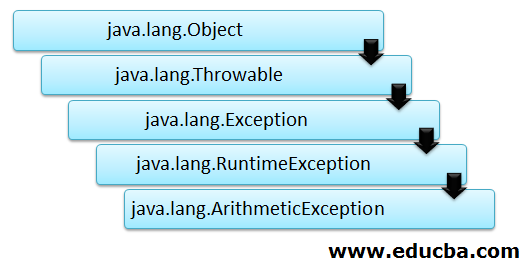
Introduction to Java ArithmeticException
Java Arithmetic Exception is a kind of unchecked error or unusual outcome of code that is thrown when wrong arithmetic or mathematical operation occurs in code at run time. A runtime problem, also known as an exception, occurs when the denominator is integer 0, the JVM is unable to evaluate the result, and therefore the execution of the program is terminated, and an exception is raised. The point at which exception has raised the program terminates but code earlier to that is executed, and the result is shown.
The base class of java arithmetic exception is lang.ArithmeticException, which comes under java.lang.RuntimeException.
Structure of ArithmeticException in Java
Structure of base Class ArithmeticException:
Constructor of ArithmeticException
1. ArithmeticException(): Define an Arithmetic Exception with no parameter passed or with not any detailed message.
2. ArithmeticException(String s): Define an ArithmeticException with one parameter passed.
s: s is the detailed message
How ArithmeticException Work in Java?
Below are the two situations that can lead to Java ArithmeticException:
- Division of a number by Zero which is not defined and an integer.
- Non-terminating long decimal numbers byBig Decimal.
1. Division of a Number by an Integer Zero
An arithmetic exception in java is thrown when we try to divide a number by zero. Below is the java code to illustrate the operation:
Example #1
Code:
package com.java.exception;
public class ArithmeticException
{
void division(int a,int b)
{
int c=a/b;
System.out.println("Division has been successfully done");
System.out.println("Value after division: "+c);
}
public static void main(String[] args)
{
ArithmeticException ex=new ArithmeticException();
ex.division(10,0);
}
}Output:
- lang.ArithmeticException: Exception thrown by java language during division
- / by zero: It is the detailed message given to the class ArithmeticException while generating the ArithmeticException instance.
As we have divided 10 by 0, where 0 is an integer and is undefined, it throws above arithmetic exception.
Example #2
Code:
//package com.java.exception;
public class ArithmeticException
{
void division(int a,int b)
{
int c=a/b;
System.out.println("Division of a number is successful");
System.out.println("Output of division: "+c);
}
public static void main(String[] args)
{
ArithmeticException ex=new ArithmeticException();
ex.division(10,5);
}
}Output:
2. Non-Terminating Long Decimal Numbers by Big Decimal
Java has a BigDecimal class that represents decimal numbers up to a large number of precision digits. This class of java also has some set of functionalities that are not available in the primitive data types, for example, integer, doubles, and floats. These functionalities provide rounding off the decimal numbers
Below is the code for illustration:
Example #1
Code:
//package com.java.exception;
import java.math.BigDecimal;
public class ArithmeticException
{
public static void main(String[] args)
{
BigDecimal a=new BigDecimal(1);
BigDecimal b=new BigDecimal(6);
a=a.divide(b);
System.out.println(a.toString());
}
}Output:
In the java code written above, as the big decimal class doesn’t know what to be done with the division output, hence it throws or shows an arithmetic exception in the output console.
It throws an exception with a detailed message “Non-terminating decimal expansion, no exact representation.”
One possible way out for the above big decimal class is to state the number of decimal places we need from a big decimal number and then limit the value to a definite number of decimals. For example, c should be limited to 7 decimal places by rounding the number upto the 7th decimal precision value.
Example #2
Code:
//package co.java.exception;
import java.math.BigDecimal;
public class ArithmeticException
{
public static void main(String[] args)
{
BigDecimal a=new BigDecimal(1);
BigDecimal b=new BigDecimal(6);
a=a.divide(b,7,BigDecimal.ROUND_DOWN);// limit of decimal place
System.out.println(a.toString());
}
}Output:
The output console shows the result as a number with a 7th decimal point value, which means rounding works fine.
How to Avoid or Handle Java ArithmeticException?
Handling the exception thrown by java virtual machine is known as exception handling. The advantage of exception handling is the execution of the code is not stopped.
An exception is handled by using a combination of try and catch. A try/catch block is placed in the code that might generate an exception. Code written inside a try/catch block is referred to as a protected code.
Syntax:
try
{
set of statements//protected code
}
catch (exceptionname except)
{
// Catch set of statements---can contain single catch or multiple.
}ArithmeticException Handling using try & Catch Blocks
- Write the statements that can throw ArithmeticException with try and catch blocks.
- When an exception occurs, the execution falls to the catch block from an exception’s point of occurrence. It executes the catch block statement and continues with the statement present after the try and catch blocks. Below is the example:
Code:
public class ExceptionHandled
{
public static void main(String args[])
{
int x =100, y = 0;
int z;
System.out.println("Hello world");
try
{
z = x/y;
System.out.println(z);
}
catch(ArithmeticException except)
{
System.out.println("Avoid dividing by integer 0" + except );
}
System.out.println("Hello class");
System.out.println("Hello there");
}
}Output:
Hello class and Hello, there are also printed on the output console apart from Hello world. This is the outcome of the exception handling mechanism.
Explanation:
- Try, and catchblocks are exception handling keywords in Java used completely used to handle the exception or unchecked error raised in the code without halting the execution of the code.
- Detect the trouble creating statements and place them in the try block. When the try block throws the exception, the catch block handles that exception, and the execution of the program goes further to the last statement.
- If the try block does not throw the exception, the catch block is simply overlooked.
- Run a suitable exception handler or statements in the catch block to handle or detect the exception thrown by the try block successfully.
Conclusion
This article has learned about java arithmetic exception and how to handle the exception under try and catch block. An arithmetic exception occurs most of the time because of the division of a number by integer 0. In this article, I have used a single catch for a single try, but we can also use multiple catch for a single try.
Recommended Articles
This is a guide to Java ArithmeticException. Here we discuss the Introduction and how to Avoid or Handle Java ArithmeticException along with examples. You can also go through our other suggested articles to learn more –




